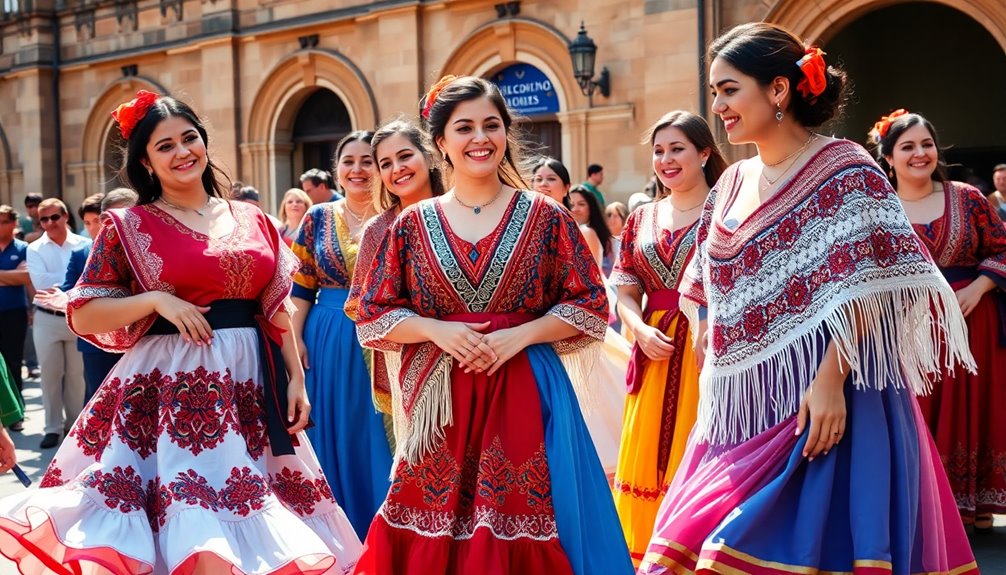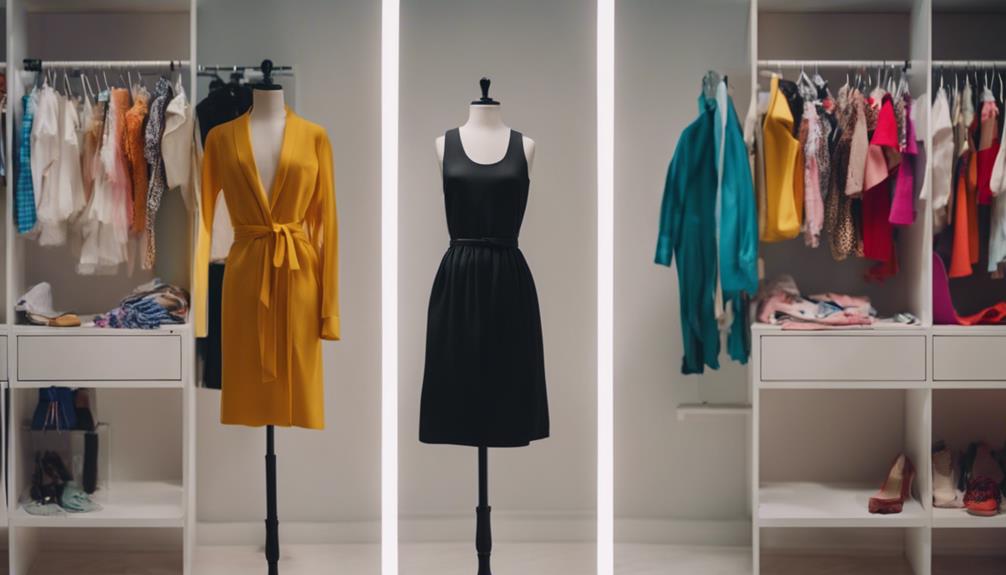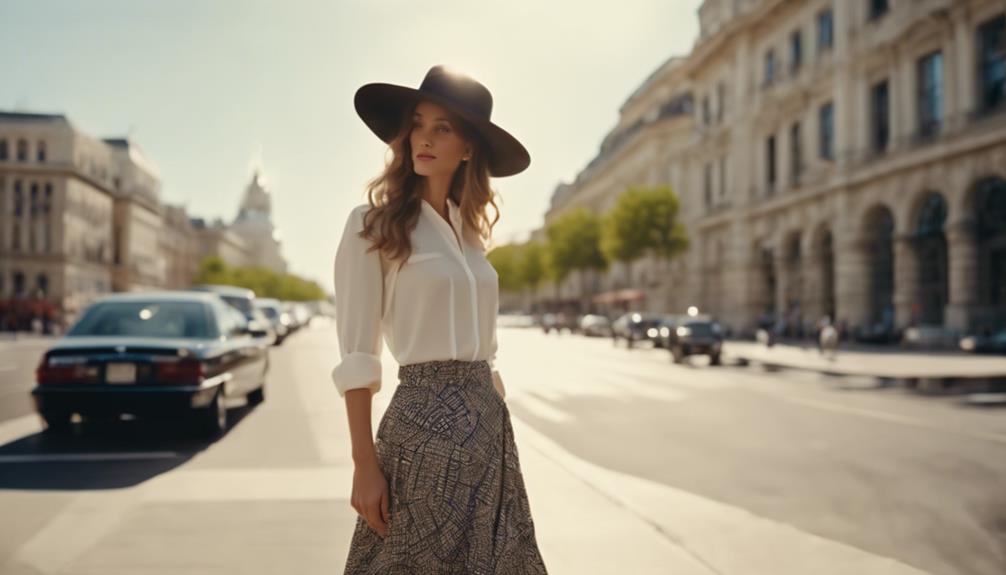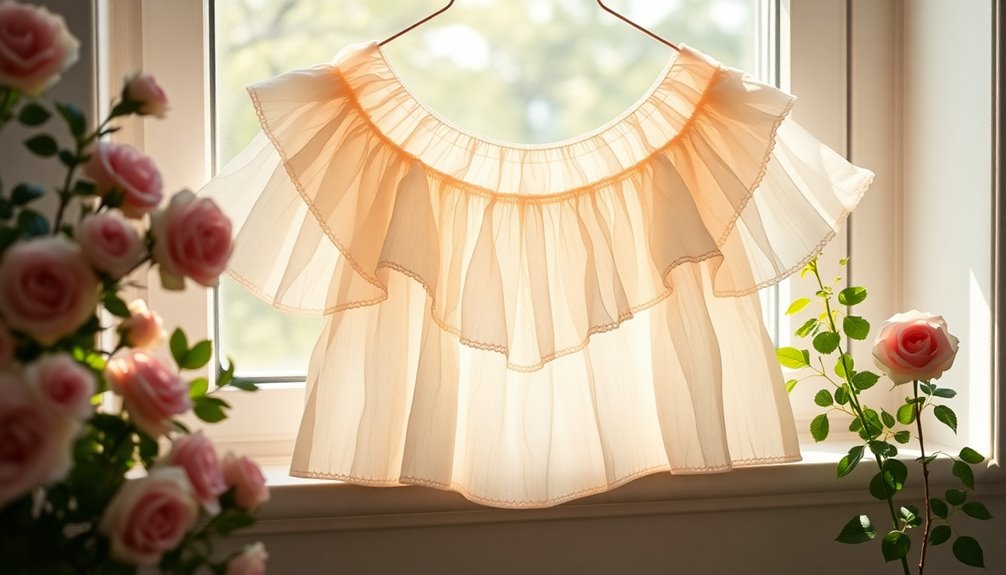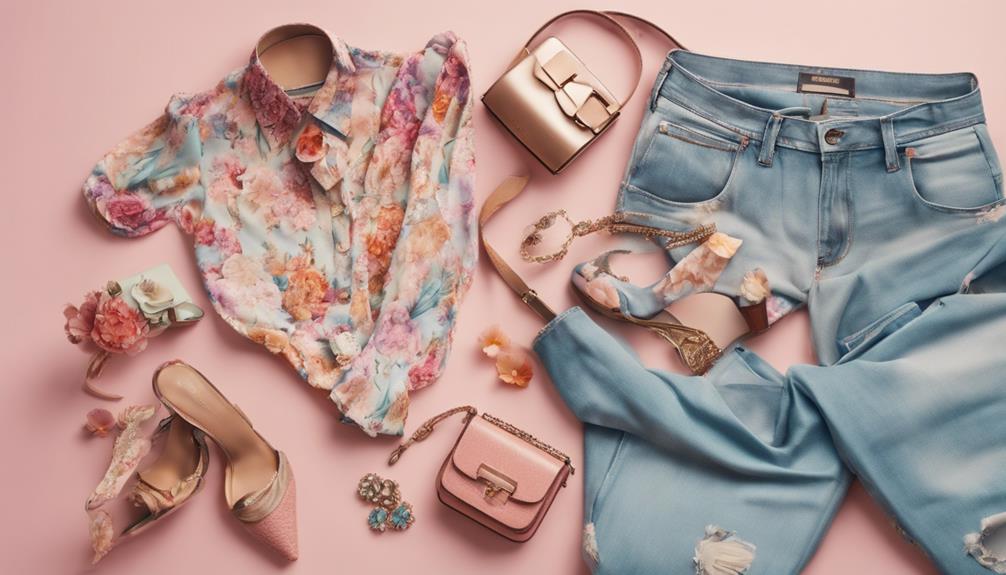Spaniard dress brilliantly celebrates cultural heritage, combining influences from Moorish, Christian, and Gypsy traditions. You'll find vibrant flamenco dresses adorned with ruffles, embodying joy and passion during festivals. Traditional attire often features rich embroidery, showcasing local craftsmanship and regional stories through colorful patterns. Modern fashion blends these timeless elements with innovative designs, promoting sustainability and inclusivity. Accessories like handcrafted mantones and mantillas add elegance and a personal touch to your look. This rich tapestry of heritage in fashion invites you to explore how these styles tell timeless stories of Spain's diverse culture. Keep going to uncover even more!
Key Takeaways
- Traditional Spanish dress showcases a blend of Moorish, Christian, and Gypsy influences, celebrating the country's rich cultural heritage.
- Flamenco attire, featuring ruffled skirts and vibrant colors, embodies Andalusian culture and serves as a symbol during festive celebrations.
- Unique regional styles, such as the Valencian huertana and Basque dress, highlight local traditions and contribute to Spain's diverse fashion landscape.
- Modern Spanish fashion incorporates traditional elements while prioritizing sustainability and inclusivity, reflecting contemporary values in cultural expression.
- Accessories like embroidered shawls and mantillas enhance traditional outfits, connecting wearers to Spain's rich history and cultural significance.
Origin and historical background of the fashion trend/style
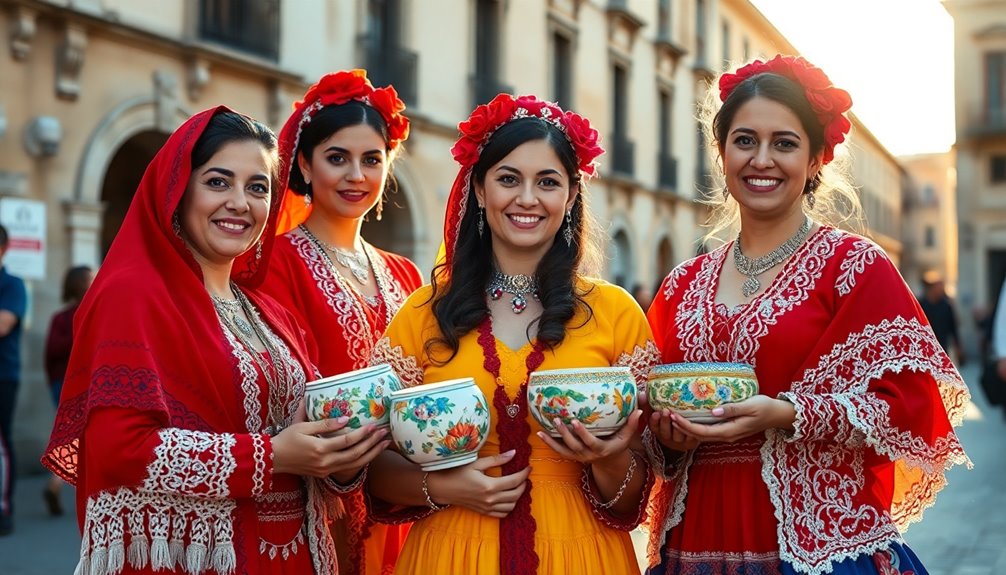
You can't ignore how historical transformation shaped Spanish dress over centuries.
Trade routes played a crucial role, introducing diverse fabrics and styles that influenced regional attire.
As you explore this rich tapestry of fashion, you'll see how each piece tells a story of cultural exchange and heritage.
Historical Transformation of Styles
Evolving over centuries, traditional Spanish dress reflects a rich tapestry of cultural influences, including Moorish, Christian, and Gypsy traditions. Each region has developed its unique styles, showcasing the diverse heritage of Spain.
The flamenco dress, with its ruffled skirts and vibrant colors, emerged from Andalusian culture and embodies the passion of its dance. As you explore this dynamic fashion, you'll notice how it captures the spirit of celebration and emotion.
The mantilla, a delicate lace veil dating back to the 16th century, stands as a symbol of Spanish femininity and elegance. Often worn during significant religious and cultural ceremonies, it continues to connect modern wearers to their historical roots.
Regional variations like the Valencian huertana dress and Basque attire illustrate the unique agricultural and cultural heritage of their areas, featuring intricate embroidery and distinct styles.
In Andalusia, the traje corto showcases a blend of tradition and modernity, with its fitted bodice and voluminous skirt celebrating the region's rich cultural history.
Through these transformations, traditional Spanish dress remains a vital expression of identity and heritage, inviting you to appreciate the beauty of its evolution.
Historical Trade Routes
The evolution of traditional Spanish dress is deeply intertwined with historical trade routes that facilitated the exchange of textiles and fashion ideas.
During the 16th century, the Silk Road and maritime routes introduced luxurious fabrics like silk to Spain, transforming Spanish fashion significantly. You can see how intricate embroidery techniques became prominent as these trade interactions flourished.
Spanish fashion didn't just stop at local influences; it absorbed elements from various cultures, including Moorish and Italian styles, thanks to these trade networks. This blending of cultures contributed to the unique regional styles and aesthetics that characterize traditional dress today.
The Manila Galleons also played a vital role, as they brought exotic materials and designs from the Philippines to Spain during the 17th and 18th centuries.
Colonialism and trade routes further shaped the identity of traditional dress, creating garments that reflected a mix of indigenous and foreign influences.
This rich tapestry of cultural expression showcases how historical trade routes have left an indelible mark on Spanish fashion, turning it into a vibrant celebration of heritage and diversity.
Key Characteristics

When you explore traditional Spanish dress, you'll notice the vibrant embroidery and patterns that tell stories of the regions they come from.
The richly dyed cotton fabrics elevate the outfits, while traditional embroidered shawls add a touch of elegance and heritage.
These key characteristics not only celebrate Spain's diverse culture but also reflect the craftsmanship that goes into each piece.
Vibrant Embroidery and Patterns
Throughout Spain's rich tapestry of culture, vibrant embroidery and patterns stand out as key characteristics of traditional dress. You'll notice how intricate embroidery often incorporates floral motifs inspired by the region's diverse flora and fauna, reflecting Spain's varied cultural heritage. The use of vibrant colors—deep reds, blues, and greens—symbolizes joy and celebration, especially during festivals.
As you explore different regions, you'll see unique styles emerging. For instance, Andalusia showcases bold colors and elaborate designs that highlight local craftsmanship and artistic traditions. Patterns like polka dots and lace trimmings frequently adorn garments, adding to the visual richness of traditional attire.
The craftsmanship involved in creating these vibrant patterns is remarkable. Techniques are often passed down through generations, emphasizing the deep connection between traditional dress and cultural identity.
When you wear or admire these garments, you're not just appreciating the fashion but also the stories and heritage woven into every stitch. This vibrant embroidery and these patterns serve as a celebration of Spain's traditions, inviting you to embrace and honor the country's rich cultural legacy.
Richly Dyed Cotton Fabrics
Richly dyed cotton fabrics are at the heart of traditional Spanish dress, showcasing vibrant colors and intricate patterns that reflect the region's cultural heritage. You'll find these fabrics celebrated for their deep, lasting hues, often achieved through natural dyes like indigo and madder root. This connection to nature not only enhances the fabric's beauty but also underscores Spain's agricultural roots.
Cotton's lightweight and breathable qualities make it an excellent choice for warm climates, particularly in garments such as flamenco dresses. When you wear these richly dyed cotton fabrics, you embrace both style and comfort.
The textiles often feature hand-embroidered designs that narrate stories of local traditions, folklore, and historical influences, allowing you to connect with your cultural identity.
Moreover, the fusion of artistry and utility is evident in these fabrics. They're not just visually striking; they're functional for everyday wear and festive occasions alike.
Traditional Embroidered Shawls
Embodying the artistry of Spanish culture, traditional embroidered shawls, known as "mantones de Manila," play a vital role in enhancing the beauty of traditional outfits. These shawls are adorned with intricate embroidery that showcases elaborate floral designs and vibrant colors, each reflecting the rich cultural heritage of Spain. Made from luxurious materials like silk or wool, they exude elegance, especially during festive occasions.
Typically measuring around 1.5 meters by 1.5 meters, mantones de Manila are designed to be draped gracefully over the shoulders, enhancing your silhouette and movement. When you wear one, you're not just accessorizing; you're celebrating regional pride and the craftsmanship of Spanish artisans. Each shawl tells a unique story, with patterns varying by region, highlighting local culture and history.
Especially popular in Andalusia, these shawls elevate flamenco performances and local celebrations, adding a dynamic flair to traditional outfits. By donning a traditional embroidered shawl, you connect with the vibrant tapestry of Spanish heritage, making a statement that transcends time and trends.
Modern Interpretation
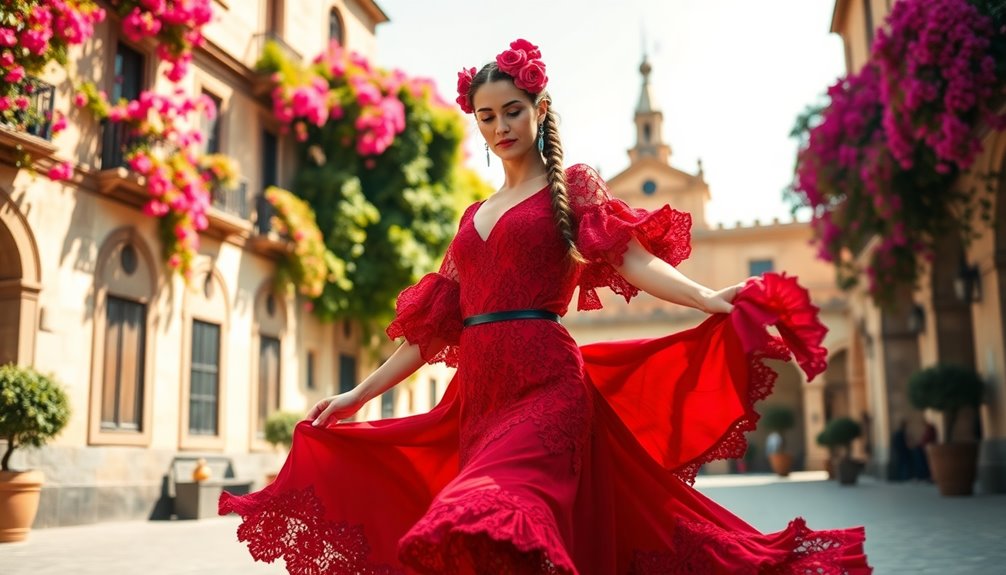
Modern interpretations of Spanish fashion fuse traditional elements with innovative designs, pushing the boundaries of style.
You'll notice that emerging labels emphasize sustainability and inclusivity, while icons like Rosalía influence trends that resonate with younger audiences.
This blend of heritage and contemporary flair makes Spanish fashion a vibrant part of today's cultural landscape.
Sustainable Fashion Innovations
Sustainable fashion innovations in Spain are transforming the industry by blending traditional craftsmanship with contemporary design. Brands like EVADE HOUSE and ACROMATYX are leading the charge, focusing on ethical practices and collaborating with local artisans to create unique collections that honor cultural identity.
These designers are reinvigorating traditional techniques, such as embroidery and artisanal tailoring, ensuring that each piece tells a story while being environmentally conscious.
The collection by PALOMO SPAIN embodies this modern interpretation, showcasing unisex garments that maintain a commitment to quality and community. This focus on sustainability reflects a growing consumer demand for authentic representation and ethical practices within the fashion landscape.
By integrating historical inspirations with modern aesthetics, contemporary Spanish designers demonstrate that local creativity can flourish globally. Additionally, the emphasis on ethical practices highlights a broader trend towards accountability within various industries, including fashion.
As you explore the world of sustainable fashion innovations, you'll notice how these developments not only celebrate Spain's rich cultural heritage but also pave the way for a more responsible future in the fashion industry.
Embracing these trends allows you to support a movement that values creativity, community, and sustainability, making every purchase a step toward preserving both tradition and the environment.
Emerging Spanish Fashion Labels
There's a vibrant wave of emerging Spanish fashion labels redefining the landscape with their unique interpretations of traditional styles. Brands like EVADE HOUSE focus on craftsmanship and sustainability, weaving themes of freedom and identity into their garments. This modern take on traditional aesthetics resonates deeply in today's fashion scene.
ACROMATYX, founded by Xavi Garcia and Franx de Cristal, blends music with fashion, presenting original compositions within their collections. Their commitment to ethical practices also sets a standard for contemporary Spanish fashion.
Meanwhile, PALOMO SPAIN, led by Alejandro Gómez Palomo, takes inspiration from iconic Spanish traditions such as flamenco and bullfighter suits, reimagining them into stylish unisex pieces that appeal to a diverse audience.
These emerging Spanish fashion labels challenge the dominance of established brands like Zara and Mango, showcasing the growing importance of local talent and sustainable practices. As young designers embrace their heritage while pushing beyond stereotypes, collaborations—like Rosalía's with Ralphie Choo—further highlight this shift.
In this dynamic landscape, you'll find a rich celebration of culture and innovation, making Spanish fashion more exciting and relevant than ever.
Fashion Icons Shaping Trends
In recent years, fashion icons have emerged from Spain, reshaping trends with their unique blend of tradition and innovation. Designers like Alejandro Gómez Palomo are at the forefront, incorporating elements like the traje de luces and flamenco into modern, unisex garments. This fusion not only honors Spain's rich cultural heritage but also makes it accessible to a global audience.
You'll notice that emerging brands such as EVADE HOUSE and ACROMATYX emphasize craftsmanship and sustainability, challenging the fast fashion giants like Zara and Mango. They're committed to promoting local artisans and ethical practices, which resonates with today's conscious consumers.
Rosalía's global success has further inspired a new wave of designers to embrace and reinvent traditional aesthetics, mixing them with contemporary influences, especially in music and performance.
The increasing popularity of regional fashion events showcases this evolution, highlighting collaborations with local artisans that preserve and modernize Spain's sartorial heritage.
Using social media and digital platforms, these fashion icons effectively connect with audiences worldwide, weaving unique cultural narratives into their collections. This modern interpretation of tradition is paving the way for Spain's vibrant fashion future.
Styling Tips
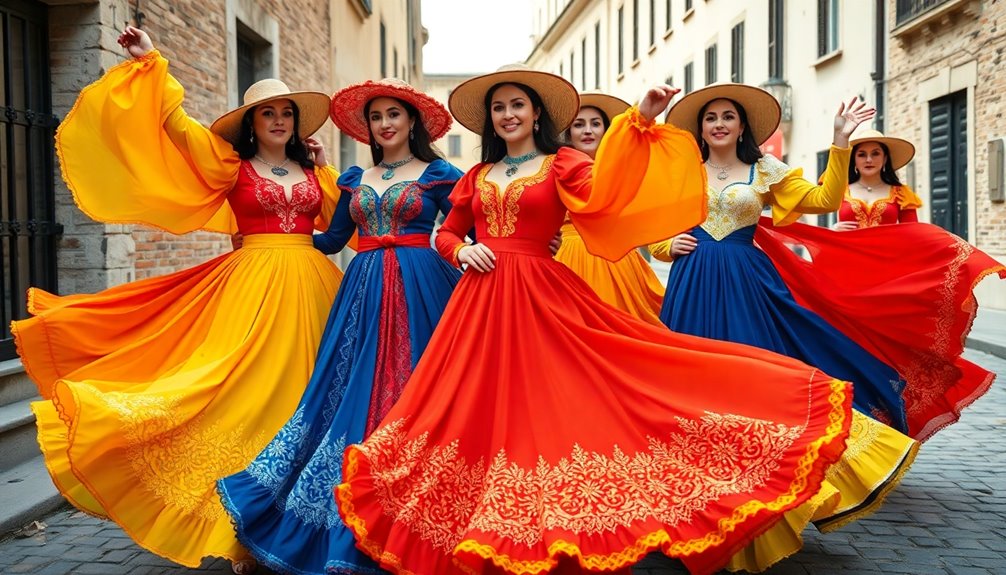
When styling your outfit, don't overlook the power of an embroidered shawl to add flair and warmth. Pair it wisely with your dress to enhance the overall look, ensuring the colors and patterns complement each other. Combining different shawl styles with your attire can transform your ensemble while celebrating Spanish heritage. Additionally, consider the benefits of breathable materials in your shawl to enhance comfort and style throughout the day.
Essential Embroidered Shawls
Embroidered shawls, or mantones, are a stunning way to showcase your style while honoring Spanish heritage. These essential embroidered shawls, often crafted from silk or wool, feature intricate floral patterns that reflect Spain's rich artistry.
You can style your mantón in various ways to enhance your look. For a classic vibe, drape it over your shoulders, letting the beautiful embroidery cascade elegantly. If you're dressing up for a flamenco event, wrap the shawl around your waist to complement the traditional dress and highlight your silhouette.
When selecting your mantón, consider the color and embroidery style that best matches your outfit. Bold, vibrant hues can make a striking statement, while more subdued tones can elevate formal attire with subtle elegance.
Incorporating a mantón into your everyday wardrobe can transform casual outfits into chic ensembles, effortlessly blending modern fashion with cultural significance.
Embroidered Shawl Pairings
Pairing an embroidered shawl with your outfit can transform your look and showcase your heritage beautifully. These elegant accessories, often crafted from silk or wool, are perfect for enhancing traditional Spanish outfits. When you drape an embroidered shawl over your shoulders or wrap it around your waist, it adds sophistication and a touch of cultural significance to your ensemble.
If you're wearing a flamenco dress, an embroidered shawl can elevate your overall look while providing warmth during cooler evenings at festivities. Choose a shawl with intricate floral patterns and vibrant colors that complement your dress. This not only highlights the craftsmanship of Spanish artistry but also reflects your personal style.
Don't limit embroidered shawls to formal attire; they can effortlessly elevate casual outfits too. Try pairing one with a simple blouse and jeans for a modern twist, adding a layer of cultural expression to your everyday wear.
Shawl and Dress Combinations
Incorporating shawls into your outfit opens up a world of styling possibilities, especially when paired with traditional Spanish dresses. The delicate mantilla, for instance, adds an air of sophistication and cultural authenticity to formal dresses, making it an excellent choice for special occasions.
When you choose a shawl, consider options like the Manila shawl, which often features intricate embroidery. This type of shawl not only serves as a stylish accessory but also provides warmth during celebrations.
Pair vibrant flamenco dresses with contrasting shawls to enhance the visual appeal, creating a dynamic interplay of colors and textures that bring life to your festive attire.
Think about the fabric weight and pattern when styling your shawl and dress combinations. Lightweight shawls complement flowing dresses beautifully, while heavier shawls can add structure and depth to fitted garments.
Accessorizing your traditional dress with regional shawls honors local craftsmanship and allows you to express your personal style while celebrating Spanish heritage. Embrace these combinations to transform your look and make a statement that honors your roots.
Shopping Guide
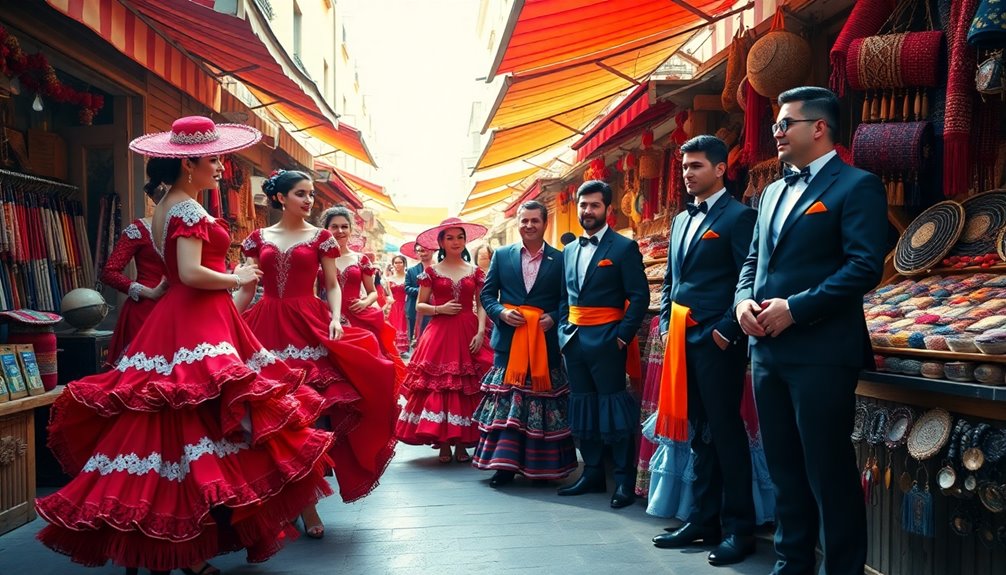
When shopping for traditional Spanish dress, you'll often find vibrant flamenco dresses that showcase ruffled skirts and bold colors, especially in local boutiques or specialty stores during festival seasons.
These dresses aren't only beautiful but also capture the essence of Spanish heritage.
Consider enhancing your look with a mantilla and peineta, which are essential accessories for any traditional outfit.
You can find mantillas in luxurious silk or delicate chantilly lace at artisan markets, adding an elegant touch to your ensemble.
Don't forget to explore regional variations, like the Valencian huertana dress, known for its intricate floral embroidery and rich fabrics.
These unique pieces are often available at regional craft fairs and specialized textile shops.
Seek out local artisans for garments that reflect traditional craftsmanship, as many communities still use age-old techniques to create stunning dresses.
Lastly, be mindful of sizing and fit; traditional Spanish dresses may have specific sizing standards.
It's wise to try on garments or consult size charts provided by sellers to ensure the perfect fit for your celebration.
Happy shopping!
Handmade Embroidered Accessories
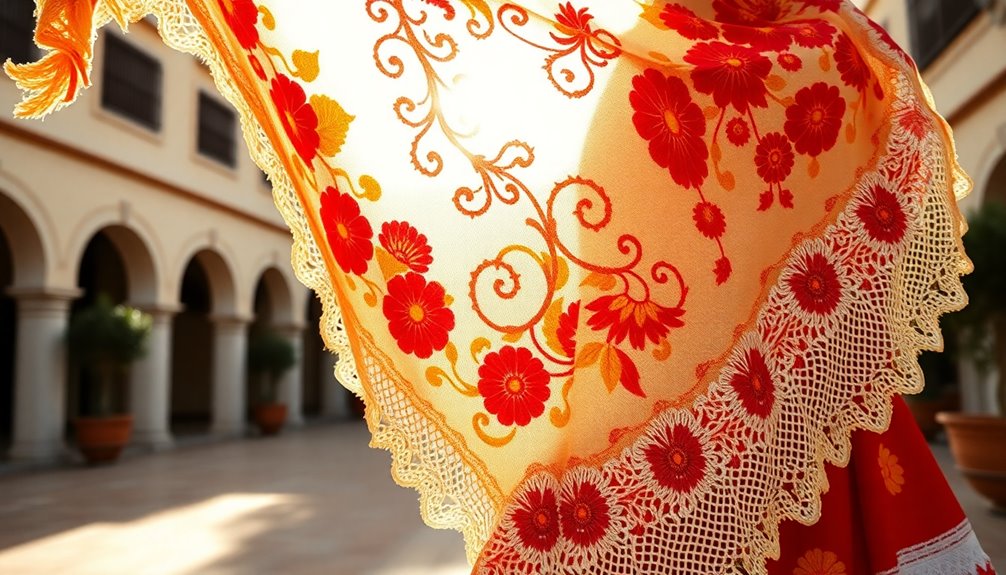
When you consider handmade embroidered accessories, handcrafted shawls stand out as a beautiful way to express your personal style.
You can personalize these pieces with unique motifs that reflect your own heritage or interests, making them truly one-of-a-kind.
As you explore different designs, you'll discover how these accessories can connect you to the rich tapestry of Spanish culture.
Handcrafted Embroidered Shawl Projects
Throughout history, handcrafted embroidered shawls have played a vital role in Spanish culture, showcasing the artistry and heritage of the artisans who create them. These stunning pieces are often made from luxurious materials like silk or wool and feature intricate designs that reflect regional motifs.
When you wear a handcrafted embroidered shawl, you're not just adding a fashionable accessory to your outfit; you're embracing a rich tapestry of identity and pride in Spanish craftsmanship.
These shawls are commonly worn during traditional festivals, serving as symbols of cultural significance. Artisans employ age-old embroidery techniques, incorporating vibrant colors and patterns that tell stories of local customs and history.
You'll appreciate the dedication and skill required to create each shawl, as it can take several days to complete one piece. This commitment preserves the traditional craft for future generations.
In recent years, the popularity of embroidered shawls has surged, with contemporary designers blending these handcrafted pieces into modern fashion collections.
This trend allows you to celebrate this heritage while expressing your personal style, ensuring that the artistry of these shawls continues to thrive in today's world.
Personalize With Unique Motifs
Handmade embroidered accessories offer a unique way to express your personal style while honoring Spain's rich cultural heritage. These beautiful pieces, such as shawls and handbags, are crafted by local artisans who pour their skill and artistry into every stitch. By choosing handmade embroidered accessories, you're not just adding flair to your outfit; you're embracing intricate designs that reflect regional identities and cultural stories.
The vibrant colors and unique motifs found in these accessories serve as both decorative elements and symbols of cultural pride. Each region in Spain, like Andalusia and Valencia, boasts distinct embroidery styles, showcasing historical influences and craftsmanship techniques that have been passed down through generations.
This diversity allows you to find pieces that resonate with your personal journey while connecting you to Spain's broader cultural tapestry. With the rising popularity of these handmade accessories, you can easily personalize your wardrobe, making it a celebration of both your individuality and heritage.
Cultural Impact
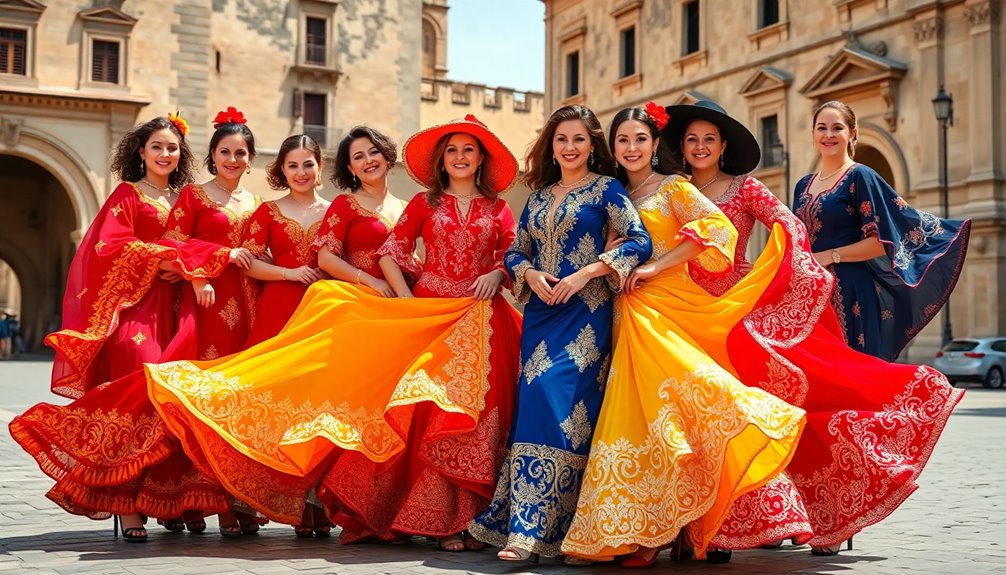
Flamenco's vibrant presence in film and music showcases how traditional dress can amplify cultural identity and activism.
When you see a flamenco dancer, you're not just witnessing art; you're experiencing a powerful expression of Spanish heritage.
This connection between fashion and cultural pride fuels a movement that resonates with both the past and the present.
Flamenco in Film and Music
Flamenco has woven itself into the fabric of film and music, serving as a vibrant emblem of Spanish culture. In movies like "Carmen" and "The Spanish Apartment," flamenco is portrayed as a passionate expression of Spanish identity, captivating audiences with its intricate choreography and emotive music.
Renowned Spanish filmmaker Carlos Saura has played a pivotal role in bringing flamenco to the forefront of cinema, highlighting its emotional depth in films such as "Flamenco" (1995) and "Carmen" (1983).
The music itself, with its intricate guitar riffs and soulful singing, has inspired countless artists across genres, enhancing the global popularity of Spanish culture. Modern artists like Rosalía have taken flamenco to new heights, blending it with contemporary styles and renewing interest in traditional Spanish dress, especially the iconic flamenco dress.
This beautiful attire not only symbolizes flamenco's rich heritage but also reflects its artistry, showcasing the cultural significance of Spain. Personal debt forgiveness bills can also impact many artists by providing them financial relief, enabling them to focus on their creative expressions.
As flamenco continues to thrive in film and music, it remains a powerful representation of Spanish cultural identity, inviting you to celebrate its beauty and history.
Cultural Identity and Activism
Cultural pride has surged among Spain's youth, as they increasingly embrace traditional dress as a symbol of their heritage. This shift highlights a desire to reclaim their identity, moving away from foreign influences. Artists like Rosalía are leading this charge, blending contemporary sounds with cultural roots, inspiring others to do the same.
Emerging fashion brands like EVADE HOUSE and PALOMO SPAIN are also redefining Spanish fashion. They incorporate traditional elements, such as fitted bodices and silver embroidery, into modern designs, emphasizing sustainability and local craftsmanship. This approach not only celebrates heritage but also stimulates activism within the fashion realm.
Designers are challenging stereotypes and promoting inclusivity, showcasing how traditional attire can unify diverse cultural identities. Festivals serve as a vibrant platform for this activism, allowing people to express cultural pride while advocating for the preservation of regional heritage. These events not only celebrate cultural richness but also provide opportunities for designers to introduce affordable fashion choices that cater to a wide audience. For instance, many are now offering cheap graduation dress options that reflect various cultural elements, blending modern trends with traditional designs. This approach not only makes fashion more accessible but also encourages individuals to embrace their heritage in contemporary settings.
Collaborations between local artisans and contemporary designers further underscore the importance of traditional craftsmanship, helping sustain age-old techniques. By incorporating these rich sartorial histories into their work, they foster a deeper connection to Spain's culture, ensuring that its legacy thrives for future generations. Faith and resilience are also integral to this movement, as they empower individuals to embrace their roots and express their identity proudly.
Frequently Asked Questions
What Is the Name of Spain Cultural Dress?
Spain's cultural dress varies widely across its regions, with names like the Flamenco dress from Andalusia and the Huertana dress from Valencia.
Each outfit showcases unique styles and vibrant colors that reflect local traditions. You might also encounter the traje corto in southern provinces or the elegant Mantilla, a lace veil symbolizing Spanish femininity.
These traditional dresses embody craftsmanship and pride, connecting you to Spain's rich cultural heritage every time you see them.
What Is the Fashion Culture in Spain?
Spain's fashion culture is a vibrant tapestry woven from its diverse regional identities.
You'll find traditional garments, like flamenco dresses, that showcase intricate embroidery and bold colors. Major festivals, such as the Feria de Abril, invite you to experience this cultural richness firsthand.
With a blend of contemporary styles and sustainability, emerging designers are redefining Spanish fashion.
You'll notice a revival of interest in traditional attire, especially among younger generations influenced by modern artists.
How Did the Spaniards Dress?
When you look at how Spaniards dress, you'll notice a rich variety that reflects their regional identities.
In Andalusia, you might see flamenco dresses with ruffled skirts, while in Valencia, vibrant huertana dresses are common.
Accessories like mantillas and peinetas add elegance during formal events.
Each region's attire showcases unique influences, from Moorish designs to local craftsmanship, celebrating Spain's diverse cultural heritage through its traditional clothing styles.
What Is the Traditional Dress for Men in Spain?
When you explore traditional male dress in Spain, you'll find it varies by region.
In Andalusia, you might see the traje corto, a fitted suit with a wide-brimmed hat.
In the Basque Country, men wear the gerriko and the txapela beret.
The Valencian huertano outfit showcases vibrant skirts and trousers.
Additionally, you can't miss the ornate traje de luces worn by matadors, symbolizing bravery in bullfighting.
Each piece reflects Spain's rich culture.
